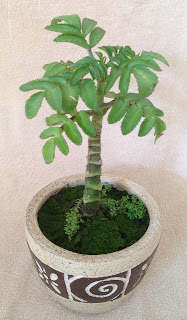The first
time I saw this plant was in one of the plant-stands in the green area of Renon,
Denpasar. At the moment, I was so interested in seeing the stout-looking boughs and the unusual
shape of the leaves. Overall, the shape of this plant is exotic in my eyesight.
When I asked about the price, I was a bit surprised, its price is ten times from the
usual plants in general at the place. The seller said that the plant’s name is Havana
Coconut, he did not know its scientific name.
I tried to
find the name by searching with Google, but it did not work. Then I asked some
friends of landscape architects by sending them the photo of this plant, they also did
not know its Latin name. Then I asked about this plant to an agriculture/landscape Professor in
Korea. He did not immediately answer, but asked me to send him the detailed picture
of the connection of the petiole and stem. I did it promptly. Not long afterwards, the Professor
informed that the plant is a kind of succulent, a very special kind of succulent
plant, named Kalanchoe prolifera. He suggested me to explore information as much as
possible about the plant, because according to him, there was some discussion
and debate about this plant.
He told me
the truth, after I visited some website links, as well as downloaded some
papers and journals about this plant, there are some controversy but interesting
about this plant. Starting from it as an invasive weed, up to it as a rare and
valued plant is quite expensive, ie up to nearly 20 US dollars that are 2 feet
tall. The plant from the succulent category is also informed as a giant plant,
but also can be as a mini plant in pots on the table as indoors. Information
about the growing medium is also varied, generally saying this plant likes to
the slightly dry sandy soil conditions, as is the cactus. However, when I found
it, this plant is presented in a pot whose surface is mossy. When I unload from the pot, the soil conditions are slightly moist clay.
There are
several benefits of this plant for health, but there are also dangers,
if part of the plant is consumed by some pet or mouse, it can cause the animal was
poisoned and even die. This plant is used as a traditional herbal medicine,
supposedly can kill cancer cells. But there is a worry if consumed a lot and in
long time continually, can cause side effects of other diseases.
One thing
that is certain and undebatable, that this plant can purify the air from carbon
and airborne chemical toxins, especially indoors where the ventilation system
is not good enough, that cause the air pollution is trapped in that room.
So, having
this plant as air purifier at home or in office is very beneficial for health.
Because breathing clean and fresh air is one of the most important
determinants for human health.
Anetha
Athena, the Founder of Bali FLO, Indoorscape Production
Note:
Many thanks
to Prof. Sung-Kyun Kim who discover the scientific name of the plant for me.
Source:
Geof Smith, DVM, PhD,
Kalanchoe species poisoning in pets, Toxicology Brief: managing common
poisonings in companion animals, Veterinary Medicine, November 2004
Lilis Siti
Aisyah, Yenny Febriani Yun, Tati Herlina, Euis Julaeha, Achmad Zainuddin, Ida
Nurfarida, Ace Tatang Hidayat, Unang Supratman and Yoshihito Shiono, Department
of Chemistry, Faculty of Mathematics and Natural Sciences, Jenderal Achmad Yani
University, Cimahi 40528, Indonesia: Flavonoid Compounds from the Leaves of
Kalanchoe prolifera and Their Cytotoxic Activity against P-388 Murine Leukimia
Cells, Natural Product Sciences 23(2) : 139-145 (2017)
Rola Milad,
Sherweit El-Ahmady and Abdel Nasser Singab, Department of Pharmacognosy,
Faculty of Pharmacy, Ain Shams University, Abbassia, 11566-Cairo, Egypt: Genus Kalanchoe (Crassulaceae): A Review of Its Ethnomedicinal, Botanical,
Chemical and Pharmacological Properties; European Journal of Medicinal Plant,
2013
YJ Hsieh, YL Leu2, CJ Chang, The anti-cancer activity of
Kalanchoe tubiflora, Critical Review, Alternative Medicine 2013, Aug 01

Great! Where can I get one?
BalasHapus